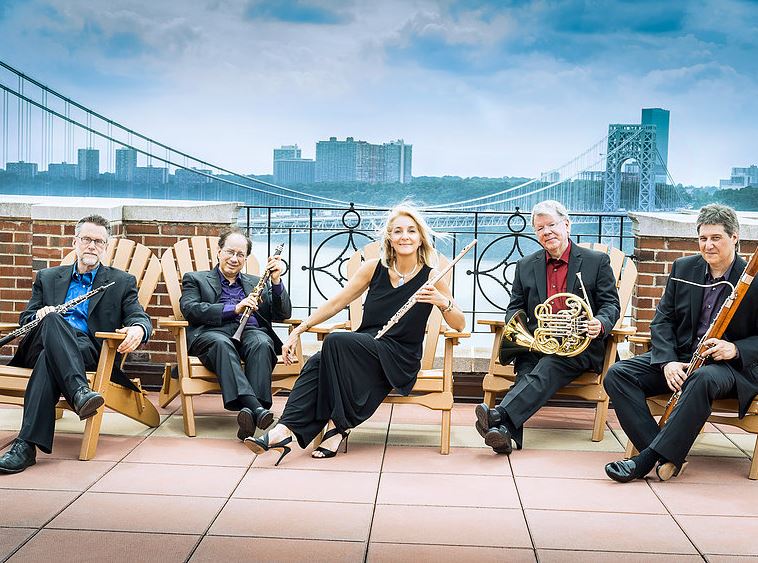Wa Concert Series presents Celebrating Winds in Review
Charles Neidich, Artistic Director
New York Woodwind Quintet:Carol Wincenc, flute/piccolo; Stephen Taylor, oboe, English horn; Charles Neidich, B-flat clarinet, E-flat clarinet; Marc Goldberg, bassoon, contrabassoon; William Purvis, horn
Tenri Cultural Center, New York, NY
May 4, 2018, 7:30 PM
One of the great delights of the New York concert season has been my discovery of the Wa series, now concluding its first year. This is truly the “caviar” of chamber music series, with its carefully curated repertoire, emphasizing unusual or neglected composers and pieces, not to mention the lavish hand-crafted menus served before, during, and after the performances, created by artistic director Charles Neidich’s wife, Ayako Oshima.
There was so much wind-superstar power in one room that it took my breath away! Better mine than theirs, however, for they would need every ounce of it to play this difficult program. In the case of musicians on this level, there was never even a hint of strain or difficulty.
The evening began with a selection of Elizabethan lutenist John Dowland’s secular dances, transcribed by hornist William Purvis, who is passionate about this period of music. He deftly and simply explained the concept of “broken consort” to the audience. The music emerged in all its eloquence, with Lachrimae Antiquae a particular highlight.
Richard Wernick’s name and music were new to me on this occasion. He was in attendance, and explained that at “his age” (Mr. Wernick is 84) he decided to compose only what he wished (not to deadlines) and only for friends, preferring to envision “faces instead of clefs” at the beginning of each stave. Thus, his friends the New York Woodwind Quintet gave the world premiere of his Quintet No. 2, a work that makes use of the color palette of the winds to differentiate the strands of counterpoint. They played the work brilliantly, clarifying every texture. Mr. Wernick’s use of klangfarbenmelodie (sound-colors melody), in which the same pitch is repeated by (or traded to) another instrument was remarkable for the way in which the transfers were subtle: one could hardly tell where one instrument began and the other left off.
Then came Elliott Carter’s second wind quintet, Nine by Five, a work completed on his 101st birthday (!). The title refers to the nine instruments played by the five members, each one doubling on another instrument (except the horn). The scenario is one of conversation/argument/ignoring/togetherness, as of actors on a stage, and again these players dramatized every moment of this raucous mini-play.
After intermission came a curio, about which I was initially anxious. How can a string quartet, essentially an intimate form for four players, be transferred to a more “public” type of ensemble, and expanded to five players, without betraying some of its substance? My fears were unfounded, as somehow I expected they would be. Once again, Mr. Purvis displayed his perfect taste-level in his rendering of the Mendelssohn String Quartet No. 2 in A minor, Op. 13. This work, begun in July 1827, has a motto that quotes from a June 1827 song Frage (Question), the question being “Ist es wahr?” (Is it true: that a secret admirer asks the moon and stars about him?) This is due to the eighteen-year-old Mendelssohn’s crush on Betty Pistor, a member of the Singakademie for whom Mendelssohn was the accompanist. Mr. Purvis explained how Mendelssohn fuses the motto technique inspired by Beethoven’s last quartet with the contrapuntal wizardry inspired by Bach. There are numerous references to various late works by Beethoven in each of the cyclic movements, which Mendelssohn wrote about: “the relation of all 4 or 3 or 2 or 1 movements of a sonata to each other and their respective parts, so that one already knows the mystery that must be in music.”
The performance was transcendent, with transparency preserved and the lightning fast “elfin” Mendelssohn interchanges among the instruments every bit as light as when heard on strings. Naturally, the work gained a bit of heft, particularly in the lower lines, but it became its own work of art, as Mr. Purvis said “because it’s so darn fun to play.” Carol Wincenc inhabits another universe of flute playing, inaccessible to mere mortals, but she was not alone in this regard. Mr. Purvis’ muted horn pronunciation of the fugue subject in the second movement was a paragon of subtlety, with the sighing affect ever so poignantly shown. As always, Mr. Neidich was in that alternative universe of perfection too, as were Stephen Taylor and Marc Goldberg.
As an encore, they offered another Purvis transcription, of a Gesualdo madrigal, another of Mr. Purvis’ passions: Moro, lasso, al mio duolo (I die, alas, in my suffering), the chromaticism of which would not be encountered again until Wagner in the nineteenth century.
Mr. Neidich stated that the concert series for next year will be made known very soon. A word to the wise music lover: Run, don’t walk, to this series.

